Writing a podcast script isn't about creating a word-for-word teleprompter reading. Think of it more like a roadmap for your episode. It's about outlining the key segments, writing in a way that feels conversational, and making sure every single part of your show gives something valuable to your listener. A script is what turns a rambling chat into a polished, professional experience.
Why a Great Podcast Script Is Non-Negotiable
Let's be real for a second. The whole "just hit record and see what happens" approach rarely works for B2B podcasts that are trying to build authority and actually make an impact. While a little spontaneity is great, a thoughtful script is your single biggest competitive advantage. It's the difference between a casual coffee chat and a tight, value-packed show that respects your listener's time.
A well-crafted script is your foundation for clarity. It forces you to get sharp on your message, organize your thoughts, and build a narrative that makes sense. This prep work ensures you hit all your key points without wandering off on tangents, which instantly boosts your professionalism and keeps your audience locked in from start to finish.
This infographic breaks down the trade-offs between a fully scripted show and a more improvisational one.
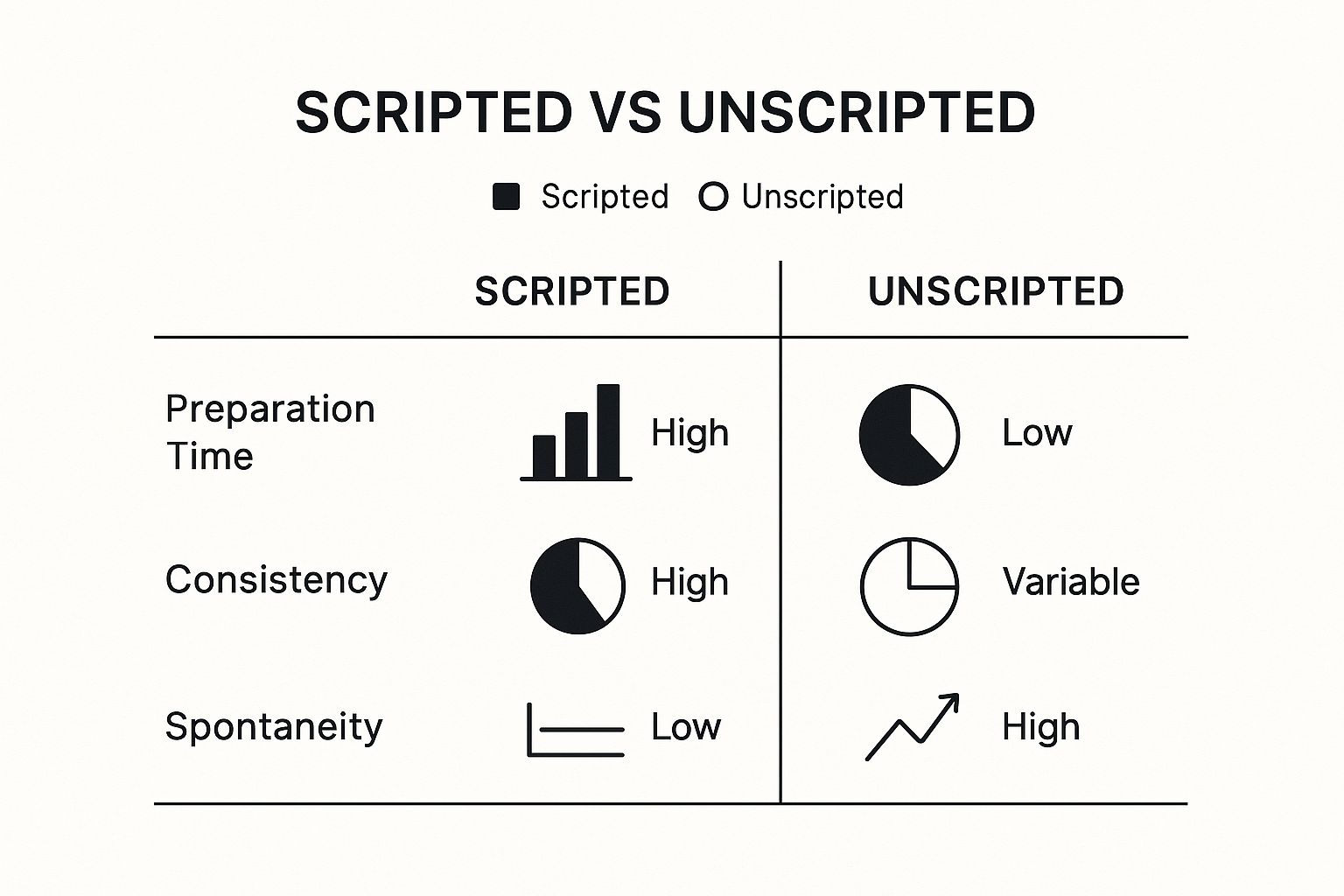
As you can see, scripting takes more work upfront, but it delivers a level of consistency that's critical for building a loyal B2B audience.
Streamline Production and Stand Out
Beyond just how you sound on the mic, scripting makes your entire production workflow so much smoother. Knowing what's coming next cuts down on recording-day jitters and gets rid of all those "ums," "ahs," and costly mistakes. All that work you do beforehand saves your editor countless hours in post-production because they get a clean, coherent track to start with.
This consistency is vital in an increasingly packed market. The podcasting world is exploding, with over 4.5 million podcasts out there and an audience expected to reach 651 million by 2027. A clear, well-structured script not only helps you stand out but also makes monetization easier. Advertisers love shows with predictable, engaging content.
Key Takeaway: A podcast script isn't a cage; it's a blueprint. It gives you the structure you need for freedom and creativity during the recording, making sure you deliver maximum value without wasting a minute of your listener's attention.
The right script structure depends on your show's format, your style, and your comfort level. There's no single "best" way, so it's worth understanding the pros and cons of each.
Scripting Approaches Comparison
This table breaks down the three main scripting methods to help you figure out what might work best for you.
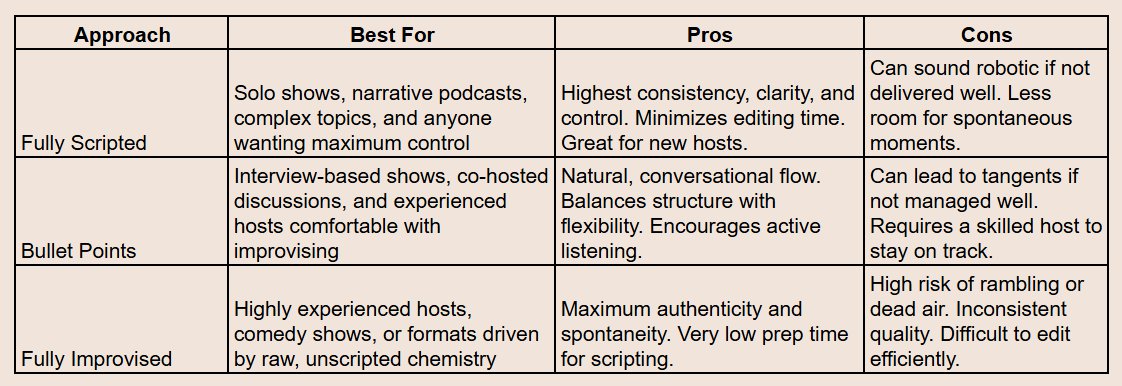
Ultimately, many of the best shows use a hybrid approach. They might fully script the intro and outro for polish, but use bullet points for the main discussion to keep it feeling natural and alive.
At the end of the day, scripting is the first real step in creating a show that doesn't just sound good but actually hits specific business goals. It's an investment in quality that pays you back in audience growth and brand authority. By planning your content, you're putting yourself in a much better position to attract and keep the listeners you want. For more on this, check out our top growth tips to get more podcast listeners. This strategic approach is how your podcast becomes a reliable asset for your brand.
Laying the Groundwork for Your Script
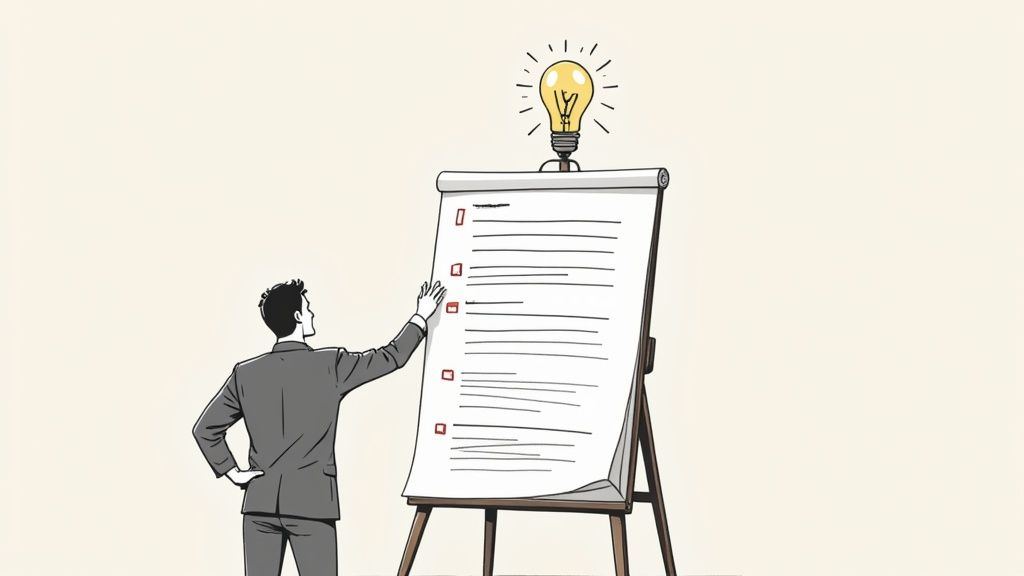
A powerful script isn't born when you start typing. It's forged much earlier, in the planning stage. This is where you take a vague idea and hammer it into a sharp, value-packed episode plan.
Trying to script an episode without this groundwork is like trying to build a house without a blueprint. Sure, you can stack some walls together, but it won't be strong, and it definitely won't be the house you envisioned.
First things first, you need a single, crystal-clear goal for the episode. Ask yourself: what is the one thing I want my B2B listener to know, feel, or do after hitting stop? It’s not about cramming in everything you know about a topic; it’s about delivering a specific, tangible outcome.
For instance, a weak goal is "talk about content marketing." A much stronger, more focused goal is "show marketers how to turn one blog post into five new pieces of content." This kind of specificity becomes your North Star, guiding every decision you make about what to include and what to cut.
Developing Your Core Message
With your goal locked in, it’s time to nail down your core message. Think of this as your episode’s thesis statement, the single big idea that everything else revolves around. A solid core message stops you from wandering off on tangents and ensures your episode has a point.
If your goal is to teach content repurposing, your core message might be: "Strategic repurposing isn't about creating more content; it's about maximizing the value of the work you've already done." See how that works? It’s memorable, actionable, and gives your entire episode a narrative backbone.
Every story you tell, every stat you share, and every point you make must tie directly back to this core message. If it doesn't, be ruthless and cut it. This is what separates a pretty good podcast from a truly great one.
Research That Resonates
Now that you have a goal and a message, you need to gather your raw materials. Remember, for a savvy B2B audience, surface-level fluff won't cut it. You need to dig deeper for compelling stories, expert insights, and data that lend your episode real weight and credibility.
Your research should hunt for things like:
- Surprising Statistics: Look for numbers that make people sit up and listen, stats that challenge old assumptions or highlight the true scale of a problem. A nugget like "76% of B2B buyers want different content at each stage of their journey" instantly makes your advice feel more urgent.
- Relevant Case Studies: Abstract advice is forgettable. Real-world examples of companies that have put your strategies into practice are not. Stories stick.
- Expert Quotes or Perspectives: What are the recognized leaders in your space saying? Pulling in quotes from articles, books, or even other podcasts shows you've done your homework and builds your authority by association.
This isn't just fact-finding. It's about collecting the building blocks you’ll use to construct a compelling narrative for your listener.
Organizing Your Material Into a Narrative
With a pile of great research, the next step is to give it structure. Don't just dump a list of facts on your audience. You need to take them on a journey. A classic, punchy framework for this is Problem-Agitate-Solve.
It's simple. First, you introduce the Problem your listener is grappling with ("Creating fresh content every week is exhausting and expensive").
Then, you aggravate that problem by digging into the painful consequences ("This leads to burnout, an empty content calendar, and missed chances to engage qualified leads").
Finally, you present your episode's core idea as the Solution ("But what if you could create a month's worth of high-quality content from a single asset?").
This narrative arc grabs attention and makes your content far more persuasive than a dry list of tips. This is how you transform a collection of notes into an episode structure. If you want more detailed frameworks, our guide on creating a winning outline for podcast episodes breaks down several effective structures. Putting in this work upfront is what makes the actual scriptwriting process feel less like a chore and more like connecting the dots.
How to Structure Your Episode for Engagement
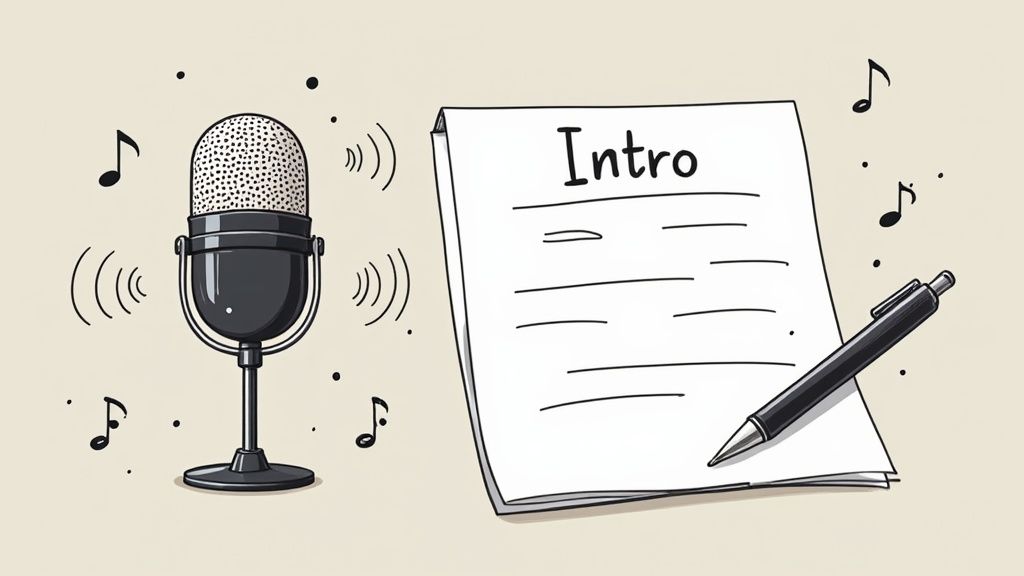
A great podcast episode isn't just a random assortment of ideas. It's a carefully crafted journey. The structure is the invisible hand guiding your listener from point A to point B, making sure they stay locked in and feel like you're respecting their time.
Think of it like the foundation and framing of a house. Without a solid structure, you just have a pile of raw materials. With one, you can build something strong, cohesive, and valuable. For B2B listeners, who are always short on time and have high expectations, a clear structure isn't a nice-to-have; it's a must.
The Magnetic Hook
You have maybe 30 seconds, tops, to convince someone to stick around. Your hook is everything. It needs to be sharp, intriguing, and promise immediate value. Don't squander this tiny window with a long musical intro or rambling pleasantries.
Get straight to the point. Pose a compelling question, drop a surprising stat, or make a bold claim that challenges a common industry belief.
- Question Hook: "What if your biggest marketing asset isn't your website, but the expertise locked inside your team's heads?"
- Statistic Hook: "Over 80% of B2B decision-makers prefer audio content to learn about new solutions. Are you meeting them where they are?"
- Bold Statement Hook: "Most companies are thinking about customer retention all wrong. Today, we're fixing that."
This first moment sets the tone and makes an implicit promise: "Stick with me, and you're going to learn something that matters."
The Introduction: Your Guidepost
Once you've grabbed their attention, the intro acts as a quick roadmap for the episode. This isn't a detailed table of contents; it's a quick, punchy preview of what’s ahead. It manages expectations and helps them settle in for the ride.
A solid intro should do three things, fast:
- Introduce Yourself and the Topic: Briefly state who you are and the core problem you're tackling in this episode.
- State the Value Proposition: Spell out what the listener will gain. For example, "By the end of this episode, you'll have a three-step framework for turning podcast guests into brand advocates."
- Tease the Main Segments: Give a high-level overview. Something like, "First, we'll break down why traditional follow-up fails. Then, we'll dive into the framework, and finally, I'll share a real-world case study of this in action."
This builds trust and shows you’ve put thought into the content. A clear path forward is reassuring and stops listeners from tuning out because they don't know where you're going.
Crafting the Main Body
The main body of your episode is where you deliver on the promises you made in the intro. To avoid a long, rambling monologue, break this section into two to four distinct, digestible segments. Each segment should tackle one key idea that supports your episode's central message.
This approach makes complex topics easier to follow and creates natural breaks for transitions, keeping the episode’s momentum alive. You can structure these segments around a story, a list of tips, or a point-counterpoint discussion.
Structuring your content pays dividends in listener retention. We've seen podcasts that use structured scripts retain up to 30% more listeners past the critical five-minute mark compared to purely improvisational shows.
A logical flow is crucial. For instance, if your episode is about improving sales demos, your segments could look like this:
- Segment 1: The most common mistakes people make in the first five minutes.
- Segment 2: How to reframe the demo around the customer's actual pain points.
- Segment 3: A simple technique for closing the demo with clear next steps.
This logical progression makes the information easy to follow and, more importantly, to remember.
The Outro and Call-to-Action
Your outro is your last chance to make an impression. Don't let your episode just fizzle out. A strong outro needs to neatly summarize the key takeaways and drive the listener toward one specific action.
First, quickly recap the most important points. This reinforces the value you delivered and helps the information stick. For example, "So remember, the three keys are..."
Next up is your call-to-action (CTA). Be specific. Give them one clear thing to do. Whether it’s subscribing to the show, visiting your website, or downloading a resource, make it simple and compelling. The best CTAs connect directly to the episode's topic, making it a natural next step for anyone who's still listening.
Of course, once the recording is done, your work isn't over. Check out our guide on what to do after the podcast interview to make sure you're getting the most out of your content.
Writing a Script That Sounds Like You
Let's be honest. The biggest hurdle in writing a podcast script is making it sound like you didn't write one. The second your delivery goes stiff or sounds like you're reading an essay, you've killed the intimate connection that makes audio so powerful.
The secret is to write for the ear, not the eye. This means you have to unlearn most of what you were taught about formal writing. We're not crafting a business whitepaper; we're sparking a conversation. It all comes down to mimicking how people talk.
Start with your sentences. Keep them short and to the point. Long, winding sentences with a bunch of clauses are a nightmare for a listener to follow. A great rule of thumb? Read it out loud. If you have to gasp for air halfway through a sentence, it's too long. Chop it up.
Talk Like a Human
To make your script feel genuine, you have to use the language of everyday conversation. Don't shy away from contractions. Real people say "it's," "don't," and "we'll," so your script should, too. Spelling out "it is" or "do not" is a dead giveaway that you're reading from a page.
Keep your language simple and direct. Your B2B audience is sharp, but they're probably listening while driving, working out, or clearing their inbox. Avoid bogging them down with jargon or overly technical terms. If you have to use a specific term, just take a second to explain what it means. Your goal is to be clear, not to sound like a thesaurus.
Think about how you move from one idea to the next. Natural transitions are your best friend. They act as signposts for the listener, making the whole episode feel more like a guided chat.
- "So, what does this mean for your team?"
- "Now, that brings up an interesting point..."
- "On the flip side, you have to consider..."
Your script is a performance tool, not a literary masterpiece. Its only job is to help you sound clear, engaging, and authentic. If a word or phrase feels weird to say, cut it. No questions asked.
Inject Your Personality with Annotations
A script should be more than just the words; it should be a roadmap for your voice. This is where annotations are a game-changer. These are just personal notes you scribble into your script to guide your delivery. It's how you make sure your personality comes through loud and clear.
Don't just write down the information. Write down the performance. This one little trick can completely transform how your script sounds on tape.
Common Annotation Types
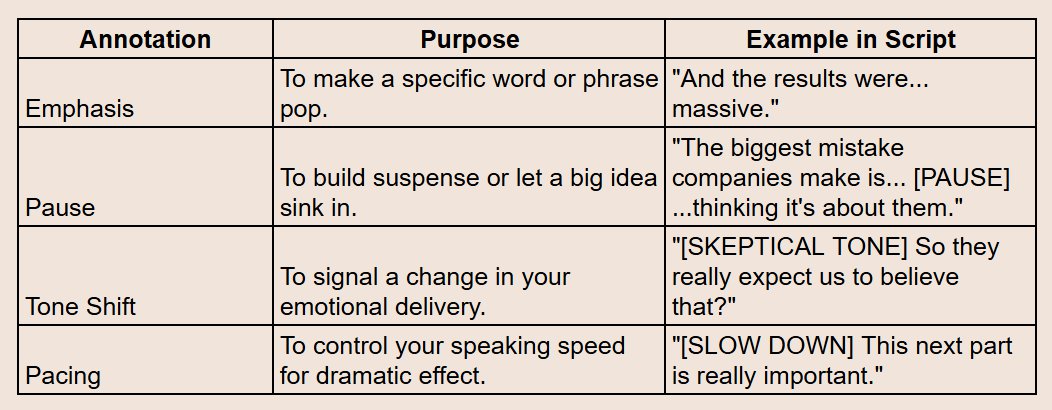
These notes are just for you, so use whatever system works. Highlight, bold, use different colors, or just scrawl in the margins. This turns a flat document into a dynamic guide for your voice and ensures the emotion you intend actually makes it into the final recording.
The Ultimate Test: Read It Out Loud
There is no skipping this step. You have to read your entire script aloud before you even think about hitting record. This is where you'll catch all the clunky sentences, the awkward phrases, and the parts that just don't sound like you.
As you read, listen for a few key things. Does it flow well? Are there any tongue-twisters or word combinations that trip you up? Does the tone feel right for the topic?
This isn't just about catching mistakes. It's about getting the words into your body. By the time you sit down at the microphone, you'll know the material so well that you can deliver it with confidence, looking up from the script and speaking directly to your audience. And that's the magic trick, making a well-written script completely invisible.
Don't hit record just yet.
Your first draft is a great starting point; it's a collection of solid ideas and structured thoughts. But it's just raw material. Now comes the fun part: turning that clay into a polished, performance-ready script that makes the actual recording session feel like a breeze.
This is the stage where you hunt down clunky sentences, fix awkward timing, and make sure your key messages hit with real force. Skipping this is like a chef sending out a dish without tasting it first. It might be okay, but it's never going to be great.
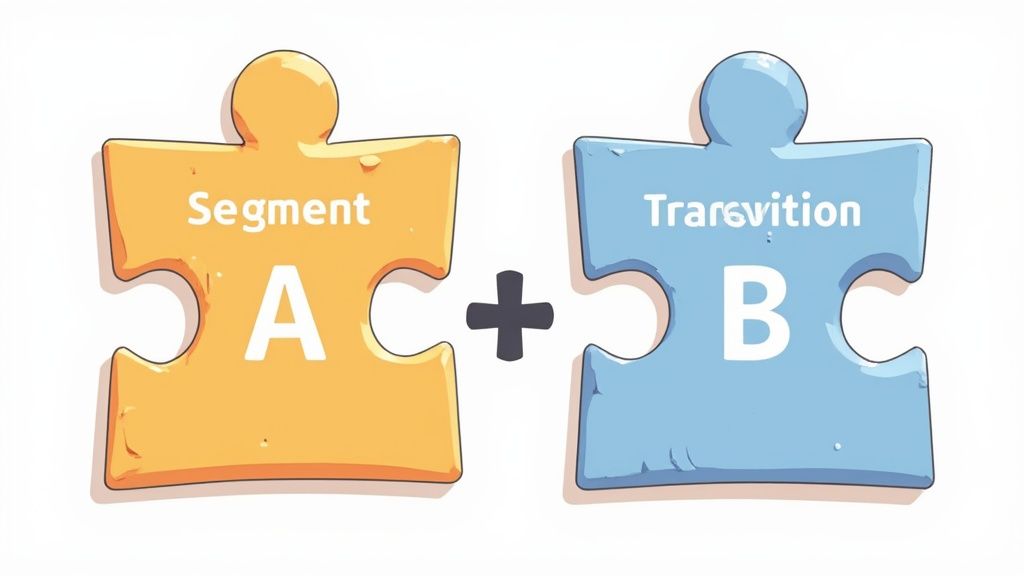
The Table Read: A Battle-Tested Tactic
One of the most powerful things you can do is a table read. It’s exactly what it sounds like: reading your script out loud, just as you plan to perform it. You can fly solo, but it's even better if you can rope in your co-host or a trusted colleague to listen.
When you read something silently, your brain is a fantastic editor; it automatically smooths over awkward phrasing and fills in the gaps. But speaking the words aloud? That's when the problems become painfully obvious. A table read is your best defense against sounding robotic or tripping over your own words on recording day.
As you read, listen for a few things:
- Awkward Phrasing: Are there any tongue-twisters or sentences that just don't roll off the tongue? Mark them.
- Rhythm and Flow: Does it sound like a natural conversation, or more like you're reading a textbook?
- Timing Issues: Does one section feel rushed? Does a joke or a key point need a bit more of a pause to land?
Going through this process helps you internalize the material. It stops being something you read and becomes something you know. That familiarity is the secret to a confident, engaging delivery when the mics are hot.
Your Practical Self-Editing Checklist
After a table read, it’s time to get a little more clinical with your editing. The mission here is to tighten, clarify, and polish every single line. This isn't about second-guessing your core ideas; it's about making sure they're presented in the sharpest, most compelling way possible.
Key Insight: The editing process is often about subtraction. Truly great scripts are defined by what you're brave enough to cut. If a sentence, a story, or a stat doesn't directly serve your episode's main goal, get rid of it.
To help you stay focused, I've put together a simple checklist. Don't try to tackle everything at once. Instead, go through your script multiple times, with each pass focused on just one or two of these areas.
Script Refinement Checklist
This checklist is your guide for the final review before you even think about recording.
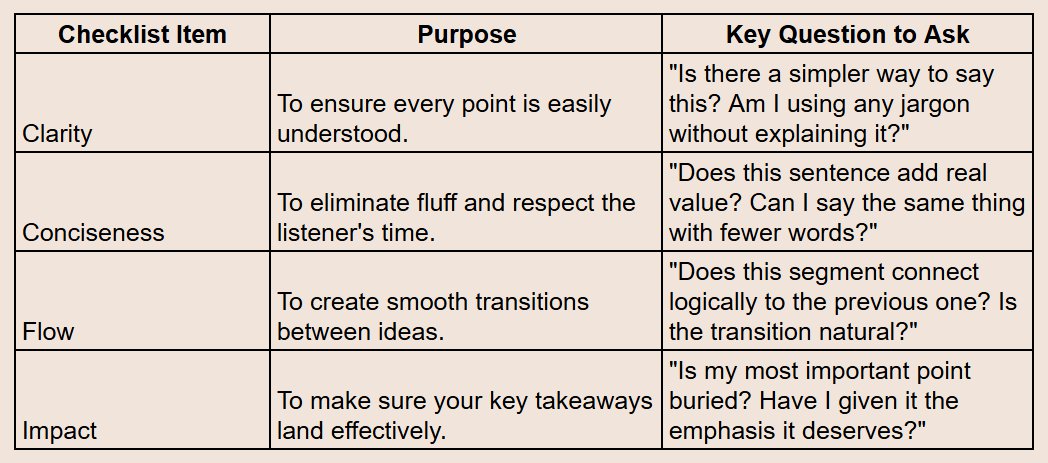
This is also the perfect time to make sure your call-to-action is sharp and compelling. A weak, vague CTA at the end of an otherwise brilliant episode is a massive missed opportunity. For some killer advice on this, check out this guide on how to craft a podcast CTA that works.
Formatting Your Script for Performance
The final piece of the puzzle is formatting your script so it's incredibly easy to use while you're on the mic. You want a document you can scan at a glance, not a dense wall of text that makes you lose your place.
Font Size and Spacing
Use a large, clean font (think 14pt or 16pt) and bump up your line spacing to 1.5 or double-spaced. All that white space makes the text much easier to follow, reducing eye strain and the chance you'll accidentally skip a line.
Color-Coding and Highlights
This is a pro move. If you have a co-host or guest, assign different colors to each speaker. You can also use highlighters to mark key points you need to emphasize, specific stats, or important transitions. It’s a simple visual system that helps your brain process information way faster than just reading plain text.
This level of prep isn't just for you; it's for your listeners. Research shows that audiences prefer concise, well-structured episodes, with 53% of podcasters aiming for that sweet spot of 20-40 minutes. And with 34% of Americans listening to an average of 8.3 episodes a week, a refined script helps you meet their expectations and seriously improves your production workflow.
Of course, a perfect script is only half the battle; your delivery is what brings it to life. For more on presenting yourself with confidence, check out these essential tips for pre-recorded content. Taking these extra steps to refine your script and prepare for delivery is what separates the amateurs from the pros.
Even with the best plan in the world, questions are going to pop up the moment you sit down to write your podcast script. It’s all part of the process, finding a rhythm that works for you, your show, and most importantly, your audience.
I get asked about this stuff all the time. This section is designed to tackle those practical, in-the-weeds challenges. We'll cover everything from finding that sweet spot between scripting and spontaneity to handling guests with grace. The idea is to give you the confidence to build a system that feels both efficient and authentic.
How Long Should a Podcast Script Be?
There's no magic number here. The length of your script is tied directly to how long you want your episode to be and, frankly, how you like to work.
As a general rule of thumb, most people speak at a rate of about 130-150 words per minute. So, if you were to write a full, word-for-word script for a 20-minute episode, you'd be looking at something around 2,600-3,000 words.
But let's be honest, almost nobody does that. A much more practical way to think about it is in pages, especially if you're using a bullet-point or detailed outline. For a typical 20-25 minute show, a well-structured 3-5 page outline is often the sweet spot. It gives you enough detail to stay on track without making you sound like you're reading from a teleprompter.
How Do I Script for a Co-Host or Guest?
When you bring other people into the mix, scripting is all about creating clarity and a shared roadmap. The last thing you want is to talk over each other or have those painfully long, awkward pauses. The solution? A shared document with crystal-clear speaker cues.
Here are a few tips that I’ve seen work wonders:
- Assign Colors: This is so simple, but so effective. Give each speaker their own text color in the script. It makes it incredibly easy to see whose line is coming up next at a glance.
- Use Name Cues: Another easy win. Just start lines with the speaker's name in brackets, like [Sarah]: or [Guest]:. It’s a clean, straightforward way to direct the flow of conversation.
- Share Questions in Advance: For guests, this is non-negotiable. Always send them the core interview questions beforehand. This isn't about getting rehearsed, canned answers. It's about giving them the space to prepare thoughtful responses, which always, always makes for a better interview.
A little bit of prep like this ensures everyone is on the same page and helps the conversation feel natural, even when it's being guided by a script.
What's the Best Way to Balance Scripting and Improvisation?
This is it. The central challenge of podcast scripting. You need structure, but you don't want to kill the spontaneity that makes a podcast feel alive. The best approach I've found is a hybrid model that gives you the best of both worlds.
Think of your script as a safety net, not a cage. It's there to catch you if you lose your train of thought, but you should feel free to stray from it when a moment of genuine insight or humor strikes.
Here’s a practical way to pull this off:
- Fully script your intro and outro. This is your chance to sound polished and professional. A tight intro hooks the listener, and a strong outro with a clear call-to-action ensures you finish with impact.
- Use detailed bullet points for the main body. For each key segment, jot down the main idea, maybe a key stat or a transition phrase, but leave yourself room to elaborate naturally. This is your conversational playground.
- Don’t script follow-up questions for guests. Prepare your main questions. But be ready to go off-script and ask spontaneous follow-ups based on what they say. This is where the magic of a great interview really happens.
This method provides a solid framework while leaving space for those authentic, unscripted moments that make listeners feel like they're right there in the room with you.
And hey, if you're frequently a guest yourself, understanding how hosts prepare can be a huge advantage. Getting a peek behind the curtain can make you a much better interviewee. You can get some great insights on this by checking out these 5 steps to find the most relevant podcasts to appear on, which gives you a feel for things from the other side of the mic.
Ready to turn your B2B expertise into a podcast that drives real business results? At Fame, we specialize in producing authority-building podcasts for B2B companies. We handle everything from strategy and scripting to production and promotion, so you can focus on sharing your message. Book a call with us today, and let's build your brand's voice.

